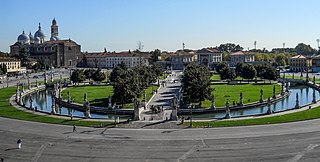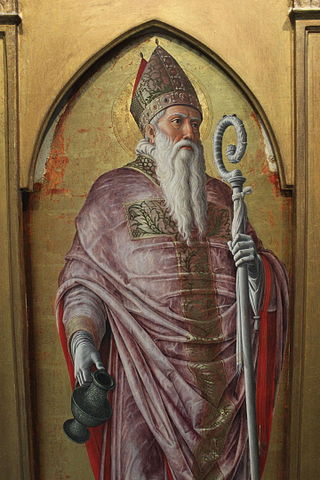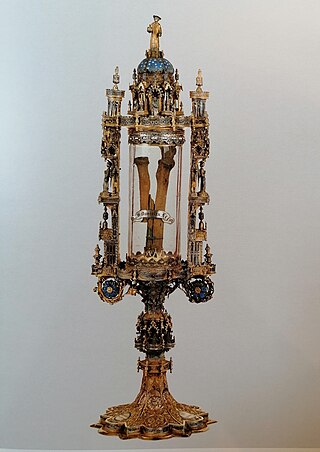
Agnes of Rome is a virgin martyr, venerated as a saint in the Catholic Church, Oriental Orthodox Church and the Eastern Orthodox Church, as well as the Anglican Communion and Lutheran Churches. She is one of several virgin martyrs commemorated by name in the Canon of the Mass, and one of many Christians martyred during the reign of the Roman emperor Diocletian.

Padua is a city and comune in Veneto, northern Italy, and the capital of the eponymous province of Padua. The city lies on the banks of the river Bacchiglione, 40 kilometres west of Venice and 29 km southeast of Vicenza, and has a population of 214,000. It is also the economic and communications hub of the area. Padua is sometimes included, with Venice and Treviso, in the Padua-Treviso-Venice Metropolitan Area (PATREVE) which has a population of around 2,600,000.

Catherine of Alexandria, also spelled Katherine is, according to tradition, a Christian saint and virgin, who was martyred in the early fourth century at the hands of the emperor Maxentius. According to her hagiography, she was both a princess and a noted scholar who became a Christian around the age of 14, converted hundreds of people to Christianity and was martyred around the age of 18. More than 1,100 years after Catherine's martyrdom, Joan of Arc identified her as one of the saints who appeared to and counselled her.

Margaret, known as Margaret of Antioch in the West, and as Saint Marina the Great Martyr in the East, is celebrated as a saint on 20 July in Western Christianity, on 30th of July by the Eastern Orthodox Church, and on Epip 23 and Hathor 23 in the Coptic Orthodox Church.

Erasmus of Formia, also known as Saint Elmo, was a Christian saint and martyr. He is venerated as the patron saint of sailors and abdominal pain. Erasmus or Elmo is also one of the Fourteen Holy Helpers, saintly figures of Christian religion who are venerated especially as intercessors.

Ursula was a Romano-British virgin and martyr possibly of royal origin. She is venerated as a saint in the Roman Catholic Church and the Anglican Communion. Her feast day in the pre-1970 General Roman Calendar and in some regional calendars of the ordinary form of the Roman Rite is 21 October.

Saint Cecilia, also spelled Cecelia, was a Roman virgin martyr and is venerated in Catholic, Orthodox, Anglican, and some Lutheran churches, such as the Church of Sweden. She became the patroness of music and musicians, it being written that, as the musicians played at her wedding, Cecilia "sang in her heart to the Lord". Musical compositions are dedicated to her, and her feast, on 22 November, is the occasion of concerts and musical festivals. She is also known as Cecilia of Rome.

Saint Bibiana is a Roman Virgin martyr. The earliest mention in an authentic historical authority occurs in the Liber Pontificalis, where the biography of Pope Simplicius (468–483) states that this pope "consecrated a basilica of the holy martyr Bibiana, which contained her body, near the 'palatium Licinianum'". The Basilica of Santa Bibiana is dedicated to her.

Juliana of Nicomedia is an Anatolian Christian saint, said to have suffered martyrdom during the Diocletianic persecution in 304. She was popular as a patron saint of the sick during the Middle Ages, especially in the Netherlands.

Victor of Marseilles was an Egyptian Christian martyr. He is venerated as a saint in the Catholic Church and the Eastern Orthodox Church.

Antonio Balestra was an Italian painter of the Rococo period.

Saints Cyprian and Justina are honored in the Catholic Church, Eastern Orthodox Church and Oriental Orthodoxy as Christians of Antioch, who in 304, during the Diocletianic Persecution, suffered martyrdom at Nicomedia on September 26. According to Roman Catholic sources, no Bishop of Antioch bore the name of Cyprian.

Prosdocimus (Prosdecimus) of Padua is venerated as the first bishop of Padua. Tradition holds that, being of Greek origin, he was sent from Antioch by Peter the Apostle. He is thus often depicted in art with this apostle. The cathedral at Feltre is dedicated to him and Saint Peter the Apostle, and the artist Il Pordenone created a work depicting Prosdocimus with Peter.

Maurice was an Egyptian military leader who headed the legendary Theban Legion of Rome in the 3rd century, and is one of the favourite and most widely venerated saints of that martyred group. He is the patron saint of several professions, locales, and kingdoms.

Piacenza Cathedral, fully the Cathedral of Santa Maria Assunta e Santa Giustina, is a Roman Catholic cathedral in Piacenza, Italy. The current structure was built between 1122 and 1233 and is one of the most valuable examples of a Romanesque cathedral in northern Italy. The dedication is to the Assumption of the Virgin Mary and to Saint Justina. It is the seat of the diocese of Piacenza-Bobbio.

Dorothea of Caesarea is a 4th-century virgin martyr who was executed at Caesarea Mazaca. Evidence for her actual historical existence or acta is very sparse. She is called a martyr of the late Diocletianic Persecution, although her death occurred after the resignation of Diocletian himself.

The Abbey of Santa Giustina is a 10th-century Benedictine abbey complex located in front of the Prato della Valle in central Padua, region of Veneto, Italy. Adjacent to the former monastery is the basilica church of Santa Giustina, initially built in the 6th century, but whose present form derives from a 17th-century reconstruction.

Praglia Abbey is a Benedictine monastery in the frazione of Bresseo in Teolo, Province of Padua, Italy. It is located at the foot of the Euganean Hills, some 12 kilometers southwest of Padua, and four kilometers from Abano Terme.

The Martyrdom of Saint Justina is a c.1570–1575 oil-on-canvas painting by the Italian painter Paolo Veronese with assistance from his younger brother, originally produced for Santa Giustina Basilica in Padua and now in the Uffizi in Florence. It shows the martyrdom of Justina of Padua.

The Reliquary of Saint Daniel is a liturgical object that comes from the Cathedral Church of Padua. This object was created by Bartolomeo da Bologna, Antonio di Giovanni and Francesco di Comino before 1472. It is now preserved in the Diocesan Museum in Padua, as part of its collection. The reliquary displays the relics of Saint Daniel, a 4th century Paduan martyr whose body is preserved in the Cathedral Church of the city.























